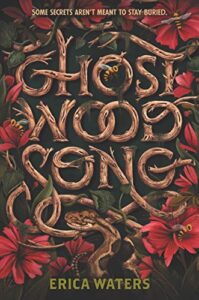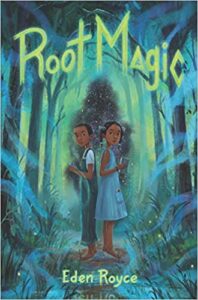
My library informed me that this year was the Return of the YA Vampire, and indeed we did see a number of YA vampire novels this year, not least of which was Stephenie Meyer’s latest addition to the Twilight saga, Midnight Sun.
For myself, I discovered I had read a number of very good books focused on witches and witchcraft.

A Deadly Education by Naomi Novik was an interesting YA title that followed a teenage witch at a boarding school for witches, who is aggressively beleagured by her powerful talent in black magic that she is trying to avoid using. The school is regularly invaded by monsters who feed on the students and their magic and also surround the school, making survival until graduation and escape afterwards a deadly challenge. This is significantly different from Novik’s previous endeavors in alternate history and fantasy, and presents a unique twist on the “boarding school” genre.

Gideon the Ninth by Tamsyn Muir is a strange combination of space opera, necromancy, and political maneuvering. In this book, there are nine Houses, each responsible for a different variety of magic. The Ninth House specializes in necromancy. When a competition for a high position working with the Emperor arises, each House is required to send a magic user with a bodyguard. Gideon, much against her will, reluctantly agrees to accompany Harrow, the powerful and very unpleasant necromancer who heads the Ninth House. I can’t even try to explain the puzzles, magic, politics, personalities, and relationship dynamics in this book except to say that Gideon and Harrow are a compelling pair, regardless of whether you love, hate, or are exasperated by either or both of them. The sequel, Harrow the Ninth, came out recently as well, and is also mindbending and disturbing.
Cemetery Boys by  Aiden Thomas is another #OwnVoices YA novel that has gotten a lot of press, and a lot of praise. Our main character, a Latinx trans boy, proves he deserves to be accepted in the coming-of-age ceremony for brujos, who can see, control, and banish ghosts. While not as thoroughly horrific as a genre reader might expect, the conclusion makes up for it, and this is an outstanding book with great representation.
Aiden Thomas is another #OwnVoices YA novel that has gotten a lot of press, and a lot of praise. Our main character, a Latinx trans boy, proves he deserves to be accepted in the coming-of-age ceremony for brujos, who can see, control, and banish ghosts. While not as thoroughly horrific as a genre reader might expect, the conclusion makes up for it, and this is an outstanding book with great representation.

The Mercies by Kiran Millwood Hargrave is a terrifying work of historical fiction strongly grounded in fact, about a fishing village of women in an isolated, freezing location are left to manage everything on their own when the men are all swept away during a storm while they are on the water. Once the government steps in, the idea that women could be competent enough to take care of themselves suggests that at least some of them must be witches. I wrote a more extensive review of this book earlier this year and I really suggest that you read it, and then read the book.

Conjure Women by Afia Atakora is an #OwnVoices work of historical fiction with threads of horror and the supernatural throughout. It alternates between “slaverytime” and “freedomtime”. The “slaverytime” storyline takes place on an unnamed plantation in the South and follows Miss May Belle, the conjure woman responsible for healing, midwifery, and sometimes, casting curses and spells. The “freedomtime” storyline is told from the point of view of Rue, Miss May Belle’s daughter, who has taken over her responsibilities as conjure woman. The former enslaved people from a burned down plantation have built a hidden village nearby. While they respect Rue at first, after she delivers a baby with a caul over its head and an illness she can’t cure causes children to sicken and die, they turn against her. There’s no way to avoid horror when evoking slavery, and Atakora based a lot of her story on oral accounts and slave narratives. While the pacing was relatively slow and not everyone will appreciate the shifting points of view, I found this a compelling story.

 The Graces by Laure Eve is a YA novel about a girl who believes she has magic and is looking for others like her. She finds them in the Grace siblings, beautiful and charismatic, who may or may not have magic. The narrator, identifying herself as River, is an unreliable reporter of events, making it a challenge to tell what is actually happening.
The Graces by Laure Eve is a YA novel about a girl who believes she has magic and is looking for others like her. She finds them in the Grace siblings, beautiful and charismatic, who may or may not have magic. The narrator, identifying herself as River, is an unreliable reporter of events, making it a challenge to tell what is actually happening.

 Cinderella is Dead by Kalynn Bayron is an #OwnVoices YA novel that explores what might happen after the happily ever after of the Cinderella story. If you’ve read any book about a repressive, patriarchal society, from The Handmaid’s Tale to The Grace Year, you’ll be able to guess that the answer is “nothing good”. 200 years after Cinderella married her true love, all teenage girls must know the government-approved version of the story by heart, and be ready to be chosen by an eligble man as his wife. Sophia would rather marry her friend Erin than any man, but she’ll have to take down the patriarchy to do it. I’d spoil the story if I revealed the part the witch takes in this story.
Cinderella is Dead by Kalynn Bayron is an #OwnVoices YA novel that explores what might happen after the happily ever after of the Cinderella story. If you’ve read any book about a repressive, patriarchal society, from The Handmaid’s Tale to The Grace Year, you’ll be able to guess that the answer is “nothing good”. 200 years after Cinderella married her true love, all teenage girls must know the government-approved version of the story by heart, and be ready to be chosen by an eligble man as his wife. Sophia would rather marry her friend Erin than any man, but she’ll have to take down the patriarchy to do it. I’d spoil the story if I revealed the part the witch takes in this story.

 Year of the Witching by Alexis Henderson is a dark tale of witchcraft, wildness, and the dangers of a patriarchal theocracy. Immanuelle is the child of a forbidden affair that led to her parents’ death and her grandparents’ ostracism, and she has been told never to enter the woods because dangerous witches live there and would seduce her into witchcraft. Entering the woods despite the warnings, she discovers her mother’s diary, which contains both evidence of her love for Immanuelle’s father and of a descent into madness. When inexplicable plagues begin to destroy her community, the head of the Church, known as the Prophet, decides they must be due to witchcraft and starts culling possible witches from the women, including Immanuelle. While the plagues send illness, darkness, and blood, the Prophet, his co-leaders, and his most devout followers are also sources of dark and terrible things.
Year of the Witching by Alexis Henderson is a dark tale of witchcraft, wildness, and the dangers of a patriarchal theocracy. Immanuelle is the child of a forbidden affair that led to her parents’ death and her grandparents’ ostracism, and she has been told never to enter the woods because dangerous witches live there and would seduce her into witchcraft. Entering the woods despite the warnings, she discovers her mother’s diary, which contains both evidence of her love for Immanuelle’s father and of a descent into madness. When inexplicable plagues begin to destroy her community, the head of the Church, known as the Prophet, decides they must be due to witchcraft and starts culling possible witches from the women, including Immanuelle. While the plagues send illness, darkness, and blood, the Prophet, his co-leaders, and his most devout followers are also sources of dark and terrible things.

 Undead Girl Gang by Lily Anderson was a surprise to me! Despite appearing on a list of YA vampire titles (there are no vampires) and a title suggesting a zombie romp, this book actually centers on a fat, Mexican, teenage witch, Mila, who is grieving the sudden death (and probably murder) of her best and only friend, Riley, following the sudden deaths (and probably murders) of Dayton and June, popular mean girls at school, all of which have been chalked up to suicide. Mila discovers a grimoire with a dark spell that will allow her to bring Riley back from the dead for seven days to help prove and solve her murder, but when she casts it, she accidentally also brings back Dayton and June– and now they’re all connected okay, so maybe it is a little of a zombie romp, but the plot centers on Mila and her witchery). The reunion with Riley isn’t exactly what Mila expects it to be, and both Dayton and June turn out to be a little more three-dimensional than they seemed while they were alive and tormenting Mila. The mystery is pretty predictable– it’s the girls, and especially Mila, who make it fun. Anderson sensitively deals with grief, death, and friendship, with touches of humor.
Undead Girl Gang by Lily Anderson was a surprise to me! Despite appearing on a list of YA vampire titles (there are no vampires) and a title suggesting a zombie romp, this book actually centers on a fat, Mexican, teenage witch, Mila, who is grieving the sudden death (and probably murder) of her best and only friend, Riley, following the sudden deaths (and probably murders) of Dayton and June, popular mean girls at school, all of which have been chalked up to suicide. Mila discovers a grimoire with a dark spell that will allow her to bring Riley back from the dead for seven days to help prove and solve her murder, but when she casts it, she accidentally also brings back Dayton and June– and now they’re all connected okay, so maybe it is a little of a zombie romp, but the plot centers on Mila and her witchery). The reunion with Riley isn’t exactly what Mila expects it to be, and both Dayton and June turn out to be a little more three-dimensional than they seemed while they were alive and tormenting Mila. The mystery is pretty predictable– it’s the girls, and especially Mila, who make it fun. Anderson sensitively deals with grief, death, and friendship, with touches of humor.

 The Once and Future Witches by Alix Harrow was also published this year, but I haven’t yet had an opportunity to read it. But there are great books of all kinds on witches, for teens and adults, for lovers for horror, fantasy, space opera, dystopia, and historical fiction… If you are looking for a little witchcraft to spice up your holiday season, you might want to check one of these out.
The Once and Future Witches by Alix Harrow was also published this year, but I haven’t yet had an opportunity to read it. But there are great books of all kinds on witches, for teens and adults, for lovers for horror, fantasy, space opera, dystopia, and historical fiction… If you are looking for a little witchcraft to spice up your holiday season, you might want to check one of these out.
















Follow Us!